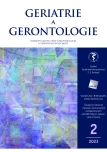Hepatic osteodystrophy in a fragility geriatric patient with liver cirrhosis
Authors:
Koudelková Gabriela; Cveková Silvia; Aiglová Květoslava
Authors‘ workplace:
2. interní klinika – gastroenterologická a geriatrická Lékařské fakulty Univerzity Palackého a Fakultní nemocnice Olomouc
Published in:
Geriatrie a Gerontologie 2023, 12, č. 2: 97-100
Category:
Overview
The geriatric population in general is a highrisk group for metabolic bone diseases. Factors contributing to the progression of bone findings are polymorbidity, malnutrition, sarcopenia and hypomobility, which are typical for elderly patients. Chronic hepatopathy of any etiology in patients over 65 years of age is a relatively common disease. When following such patients, it is always important to keep in mind the possibility of hepatic osteodystrophy, mainly involving osteoporosis and less frequently osteomalacia. Osteoporosis is the most common metabolic bone disease. Clinically, it is asymptomatic for a long time and manifests itself only in more advanced stages by the development of pathological fractures, which can greatly reduce the patient‘s quality of life, and, especially in the geriatric patient, it negatively affects morbidity and mortality. Therefore, it is very important to think about the possibility of this complication, prevent its occurrence and stratify the risk of developing this disease in advance.
In this communication, we would like to present a case report of an elderly patient with liver cirrhosis accompanied by hepatic osteodystrophy with subsequent development of multiple pathological spinal fractures.
Keywords:
secondary osteoporosis – pathological fractures – liver cirrhosis – PBC – hepatic osteodystrophy
Sources
1. Češka R. Interna. Praha: Triton, 2020; 328–337.
2. Handzlik-Orlik G, Holecki M, Wilczyński K, et al. Osteoporosis in liver disease: pathogenesis and management. Ther Adv Endocrinol Metab 2016; 7(3): 128–135.
3. Raisz LG. Pathogenesis of osteoporosis: concepts, conflicts, and prospects. J Clin Invest 2005; 115(12): 3318–3325.
4. van Leeuwen JP, van Driel M, van den Bemd GJ, et al. Vitamin D control of osteoblast function and bone extracellular matrix mineralization. Crit Rev Eukaryot Gene Expr 2001; 11: 199–226.
5. Behera J, Bala J, Nuru M, et al. Homocysteine as a pathological biomarker for bone disease. J Cell Physiol 2017; 232(10): 2704–2709.
6. Raszeja-Wyszomirska J, Miazgowski T. Osteoporosis in primary biliary cirrhosis of the liver. Prz Gastroenterol 2014; 9: 82–87.
7. European Association for the Study of the Liver. EASL clinical practice guidelines: management of cholestatic liver diseases. J Hepatol 2009; 51: 237–267.
8. Karjalainen J, Riekkinen O, Töyräs J, et al. New method for point-of- -care osteoporosis screening and diagnostics. Osteoporos Int 2016; 27: 971–977.
9. Guañabens N, Monegal A, Muxi A, et al. Patients with cirrhosis and ascites have false values of bone density: implications for the diagnosis of osteoporosis. Osteoporos Int 2012; 23: 1481–1487.
10. Cosman F, de Beur SJ, LeBoff MS, et al. National Osteoporosis Foundation. Clinician’s Guide to Prevention and Treatment of Osteoporosis. Osteoporos Int 2014; 25(10): 2359–2381.
11. Głuszko P, Lorenc R, Karczmarewicz E, et al. Polish guidelines for the diagnosis and management of osteoporosis: a review of 2013 update. Pol Arch Med Wewn 2014; 124: 255–263.
12. European Association for the Study of the Liver. EASL clinical practice guidelines: autoimmune hepatitis. J Hepatol 2015; 63: 971–1004.
13. Luxon B. Bone disorders in chronic liver diseases. Curr Gastroenterol Rep 2011; 13: 40–48.
Labels
Geriatrics General practitioner for adults Orthopaedic prostheticsArticle was published in
Geriatrics and Gerontology

2023 Issue 2
Most read in this issue
- Presbyphagia versus dysphagia – the role of the speech therapist in the management of swallowing disorders
- Frailty – prevalence of acutely hospitalized seniors from 1995 to 2022
- Mental and physical condition of patients in postacute hospital care – analysis of the results of a Czech literature review
- Results of surgical treatment of proximal femur fractures in patients operated at the Traumatology Clinic of the University Hospital Olomouc in the years 2017–2021
